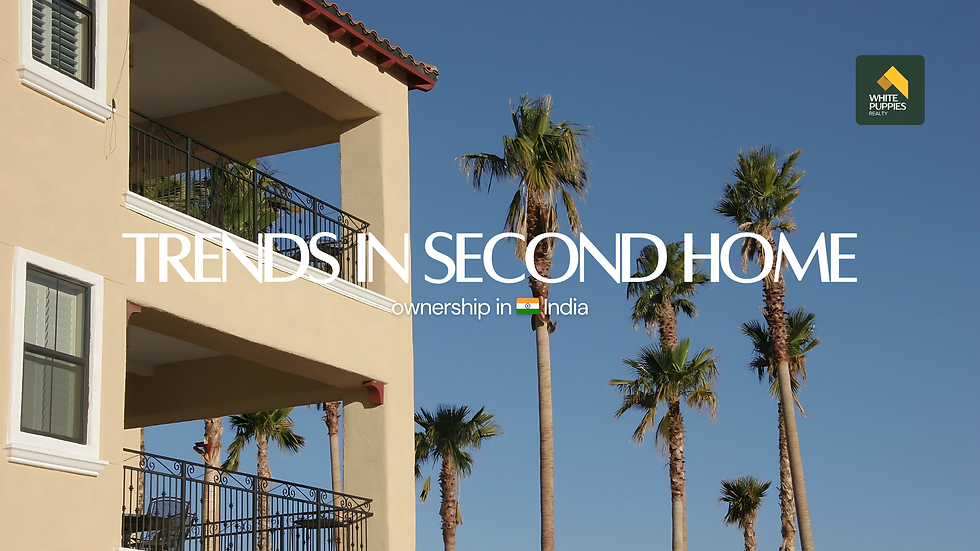The Evolution in Trends of Second Home Ownership in India
- White Puppies
- Jun 11, 2024
- 3 min read

Introduction:
The allure of owning a second home in India has grown significantly over the years, evolving from a niche market to a mainstream aspiration. Once seen as a luxury reserved for the elite, second home ownership is now more accessible, driven by changing lifestyles, increased disposable incomes, and the desire for a retreat from urban chaos. This article delves into the evolving trends in second home ownership in India, exploring modern architectural preferences, location choices, and the shifts that define the current market.
Historical Context and Initial Motivations:
Traditionally, second homes in India were often heritage properties or rural retreats inherited through generations. The primary motivation for owning such properties was to have a familial retreat, especially in culturally rich areas. These homes served as a connection to one's roots, offering a place for family gatherings and festivals.
Factors Driving the Current Surge:
In recent years, several factors have contributed to the surge in second home ownership. Economic growth has increased disposable incomes, making luxury purchases more feasible. The COVID-19 pandemic further accelerated this trend as people sought safe, private getaways away from crowded cities. The ability to work remotely has also made it possible for professionals to spend extended periods in their second homes.
Modern Architectural Preferences
Global design trends are influencing the Indian second home market. Elements such as Scandinavian minimalism, Mediterranean aesthetics, and Japanese Zen design are being incorporated into modern homes. This blend of global influences creates unique, stylish living spaces that appeal to discerning buyers.Embracing Contemporary
Design:
Today's second home buyers favor contemporary design, characterized by clean lines, open spaces, and minimalistic aesthetics. This shift reflects a desire for homes that offer both functionality and style. Modern architecture prioritizes natural light, creating airy, spacious interiors that blend seamlessly with the environment.
Sustainability and Eco-Friendly Features:
Sustainability is a key consideration in modern second homes. Eco-friendly features such as solar panels, rainwater harvesting systems, and energy-efficient appliances are increasingly popular. Buyers are keen on reducing their carbon footprint and ensuring their homes are environmentally responsible.
Smart Home Technology Integration:
Technology plays a significant role in modern homes. Smart home systems that control lighting, security, and climate remotely are in high demand. These systems offer convenience, enhanced security, and energy efficiency, making them an attractive feature for tech-savvy homeowners.
Emerging Hotspots: The Rise of Lesser-Known Destinations:
Lesser-known destinations are emerging as attractive options for second home buyers. Places like Coorg, Alibaug, and Ooty are gaining popularity due to their serene environments and relatively lower property prices. These emerging hotspots offer unique experiences and potential for significant appreciation in property value.
Luxury Amenities and Customization:
Modern second homes come equipped with a plethora of luxury amenities. Infinity pools, private cinemas, home gyms, and gourmet kitchens are just a few examples. Customization is also a key trend, with buyers opting for personalized designs and bespoke interiors that reflect their tastes and lifestyle.
Health and Wellness: Spas, Gyms, and More
Health and wellness have become paramount, especially post-pandemic. Many second homes now include dedicated wellness spaces such as spas, yoga studios, and gyms. These amenities cater to the growing demand for holistic living and self-care.
Community Living and Exclusive Clubs:
Exclusive gated communities offering a sense of community and security are highly sought after. These developments often feature private clubs, golf courses, and communal spaces that foster a sense of belonging and provide ample opportunities for social interaction.
Value Appreciation and Market Trends:
Second homes are not just about luxury; they are also sound investments. Prime properties in desirable locations tend to appreciate significantly over time. Market trends indicate steady growth in the value of second homes, making them a lucrative investment option.
Long-Term Investment Security:
Real estate remains one of the safest long-term investments. Unlike stocks or other volatile assets, property values tend to increase steadily, offering security and peace of mind. Investing in a second home also diversifies one's investment portfolio, mitigating risk.
Conclusion:
The evolution of second home ownership in India reflects broader changes in lifestyle, design preferences, and investment strategies. From contemporary architectural marvels and eco-friendly features to the allure of scenic retreats and urban escapes, the trends shaping the market are diverse and dynamic. As we look to the future, the emphasis on sustainability, technology, and holistic living will continue to drive innovation in the luxury real estate sector.
Investing in a second home is not just about acquiring a property—it's about embracing a lifestyle of comfort, elegance, and smart investment. By staying informed about emerging trends and making strategic decisions, buyers can enjoy the benefits of their second home while securing a valuable asset for the future. Whether for personal use or as a rental income source, the right second home can offer endless opportunities for relaxation, rejuvenation, and long-term financial growth.
%20(1).png)
Comentarios